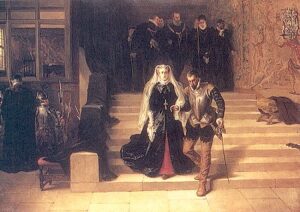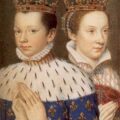
Mary thanked the men for their news, crossing herself and saying “I am quite ready and very happy to die, and to shed my blood for Almighty God, my Saviour and my Creator, and for the Catholic Church, and to maintain its rights in this country”, obviously seeing herself as a martyr. She then asked for her chaplain, a request which was denied her, and then set about preparing herself for her death. She prayed, made her will, distributed her belongings between her ladies and servants, and then wrote some letters of farewell. Her final letter was to her brother-in-law, Henry III of France, and John Guy describes how “beautifully scripted” the letter is, although there are some blotches which “may mark the places where her tears fell”. She wrote:-
“Today, after dinner, I was advised of my sentence. I am to be executed like a criminal at eight o’clock in the morning. I haven’t had enough time to give you a full account of what has happened, but if you will listen to my physician and my other sorrowful servants you will know the truth, and how, thanks be to God, I scorn death and faithfully protest that I face it innocent of any crime…
The Catholic faith and the defence of my God-given right to the English throne are the two reasons for which I am condemned, and yet they will not allow me to say that it is for the Catholic faith that I die…
I beg you as most Christian Majesty, my brother-in-law and old friend, who have always protested your love for me, to give proof now of your kindness on all these points: both by paying charitably my unfortunate servants their arrears of wages (this is a burden on my conscience that you alone can relieve) and also by having prayers offered to God for a Queen who has herself been called Most Christian, and who dies a Catholic, stripped of all her possessions…
Concerning my son, I commend him to you inasmuch as he deserves it, as I cannot answer for him…
I venture to send you two precious stones, amulets against illness, trusting that you will enjoy good health and a long and happy life.”3
It is a moving letter, written by a woman who was ready to face her death with courage and a strong faith but who was clearly worried about her servants. She was obviously a loving woman.
At 6am on the 8th February, Mary rose, after spending most of the night writing letters, and her will was read out to her household. She then said her farewells to her staff and began to pray, her prayer being interrupted by the Earls of Shrewsbury and Kent, and Thomas Andrews, Sheriff of Northamptonshire. They had come to escort her to the great hall. Mary grabbed her prayer book and her ivory crucifix and made her way to the place of her death, a hall filled with around three hundred spectators.
Alison Weir, in her book “Elizabeth the Queen”, quotes a contemporary description on Mary Queen of Scots on that fateful days:-
“On her head a dressing of lawn edged with bone lace; a pomander chain and an Agnus Dei; about her neck a crucifix of gold; and in her hand a crucifix of bone with a wooden cross, and a pair of beads at her girdle, with a medal in the end of them; a veil of lawn fasyened to her caul, bowed out with wire, and edged round about with bone lace. A gown of black satin, printed, with long sleeves to the ground, set with buttons of jet and trimmed with pearl, and short sleeves of satin, cut with a pair of sleeves of purple velvet.”4
Mary approached the straw covered scaffold, turned to her loyal ladies and said “Thou hast cause rather to joy than to mourn, for now shalt thou see Mary Stuart’s troubles receive their long-expected end.” As the Dean of Peterborough prayed aloud in English, Mary read her Catholic Latin prayers louder, and then refusing the help of the executioner, took off her black gown to reveal a scarlet bodice and petticoat. The vivid scarlet of her clothes proclaimed that she was considered herself a martyr to the Catholic faith.
The executioner knelt before the Queen of the Scots, begging her forgiveness, and then Mary knelt, laying her head on the block ready, repeating “In manuas tuas, Domine, confide spiritum meum”, “Into Thy hands, O Lord, I commend my spirit.” The executioner then did the deed, although it took him two blows to kill Mary. Alison Weir5 writes of how, when the executioner picked up Mary’s head to show the crowd, her cap and wig fell off, revealing cropped grey hair. Also, when the executioner went to remove the clothes from the body “he found her little dog under her coat, which, being put from thence, went and laid himself down betwixt her head and body, and being besmeared with her blood, was caused to be washed…”
That was the end of Mary Queen of Scots, the woman some see as a tragic heroine and martyr, and others see as an ambitious, reckless fool with poor judgement when it came to men. I love John Guy’s final words on Mary when he finishes his biography not with her death, but with her walking to her execution:-
“This was the moment. She had been the star of so many glittering spectacles during her life, beginning with her wedding to the Dauphin at Notre Dame when she was not yet sixteen, and she knew that she could keep her nerve. Her most compelling act of theatre awaited her. She stepped forward and crossed the threshold. The rest, whatever view is taken of the extent to which she truly ranks as a martyr for the Catholic faith and for the ideal of monarch, for ever settles her place in the pantheon of history as a fully realized tragic heroine.”6
But did Mary get the last laugh? On the 24th March 1603 it was her son, her flesh and blood, James VI of Scotland, who inherited the throne from Elizabeth I and became James I of England. I’m sure that Mary must have been rolling in her grave at the harsh measures which her son took against Catholics during his reign, but it was a Stewart (Stuart) on the throne of England, Mary’s destiny had been fulfilled.
You can read more about Mary in the following articles:
- Mary Queen of Scots – 8th December 1542
- The Trial of Mary Queen of Scots
- Mary Queen of Scots – Tragic Heroine?
- Mary Queen of Scots Part 1
- Mary Queen of Scots Part 2
- The Murder of Lord Darnley
Notes and Sources
- My Heart is My Own: The Life of Mary Queen of Scots, John Guy, p498-499
- Ibid., p499
- Ibid., p501
- “Elizabeth, the Queen”, Alison Weir, p379
- Ibid., p379
- Guy, p502





